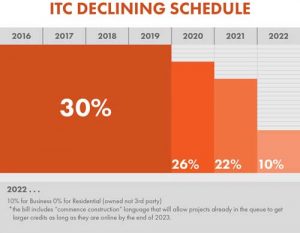- As the 2024 presidential election approaches, there's growing speculation about how a second term for Donald Trump could impact solar incentives like the Investment Tax Credit (ITC).
- If U.S. policies reduce or eliminate these credits, solar installations may become less attractive, influencing state-level incentives.
- Could this shift open the door for Canada to become a leading destination for renewable energy investments?
As the 2024 presidential election approaches, the renewable energy sector is abuzz with speculation about how a potential second term for Donald Trump could impact solar incentives, particularly the Investment Tax Credit (ITC).

In the U.S., both homeowners and businesses qualify for a federal tax credit equal to 26 percent of the cost of their solar panel system minus any cash rebates. The timeline for the eventual end of the ITC is in 2022.
The solar tax credit, officially known as the Investment Tax Credit (ITC), is a federal incentive designed to promote the adoption of solar energy systems. It allows homeowners and businesses to claim a tax credit based on a percentage of the cost of installing a solar panel system. This credit has been crucial in making solar energy more affordable and accessible.
Under the Inflation Reduction Act (IRA) of 2022, the solar tax credit was increased to 30%. This rate is set to decrease to 26% in 2033 and further to 22% in 2034, expiring in 2035.
The credit can be claimed in the tax year when the solar energy system is installed and placed into service, with any excess typically carried over to future tax years.
Biden Administration’s Impact on the ITC
President Joe Biden has been a strong advocate for renewable energy, aiming to combat climate change and promote energy independence.
Under his administration, the solar tax credit has seen significant expansion through the IRA.
Key aspects of this expansion include:
✅ Extension of the Solar Tax Credit (ITC): The IRA extended the 30% solar tax credit until 2032, with a gradual step-down to 26% in 2033 and 22% in 2034, providing long-term stability for the solar industry.
✅ Inclusion of Battery Storage: The IRA expanded the solar tax credit to include battery storage installed without solar panels, allowing homeowners to store excess solar energy.
✅ Increased Electric Vehicle (EV) Tax Credit: The IRA also boosted the electric vehicle tax credit to $7,500 for new EVs and introduced a $4,000 tax credit for used EVs, further promoting renewable energy use.
Potential Changes Under a Second Trump Presidency
Donald Trump’s first term as president was marked by policies favoring fossil fuels and rolling back environmental regulations. If re-elected, his administration might take a similar approach, potentially impacting solar incentives in several ways. Trump has shown opposition to renewable energy sources and threatened to eliminate the IRA.
If this happens, the 30% solar tax credit could be reduced or eliminated, making solar installations less financially attractive. Federal policy often influences state-level incentives, which means states aligning with Trump’s administration might also reduce their support for renewable energy projects.
Historical Examples of Trump’s Impact on Renewable Energy Policy

Trump pulling U.S. out of Paris climate deal. (Reuters)
During Donald Trump’s first term, his administration significantly impacted environmental policies, including those affecting renewable energy. In December 2020, a last-minute tax extender bill, part of an omnibus funding package, sought to extend deadlines for developers of solar, wind, and other renewable energy projects. This bill was crucial for extending federal tax credits important to the renewable sector.
However, Trump’s objections to parts of the omnibus bill created uncertainty, raising concerns that delays or a potential veto could hamper the growth of renewable energy projects.
Beyond this specific instance, the Trump administration’s broader environmental policy shifts had profound implications. Over four years, it rolled back more than 100 environmental rules, dismantling major climate policies and weakening regulations on clean air, water, wildlife, and toxic chemicals.
According to a New York Times analysis, supported by research from Harvard Law School, Columbia Law School, and other sources, nearly 100 environmental rules were officially reversed, revoked, or otherwise rolled back. An additional dozen potential rollbacks remained in progress by the end of Trump’s term.
Hana V. Vizcarra, a staff attorney at Harvard’s Environmental and Energy Law Program, described the administration’s actions as “a very aggressive attempt to rewrite our laws and reinterpret the meaning of environmental protections.”
During his first term, Trump also imposed tariffs on imported solar panels, increasing costs for U.S. consumers. A second term could see the continuation or expansion of such tariffs. Trump’s administration could roll back regulations supporting renewable energy, such as emissions standards and renewable portfolio standards, hindering the progress of solar energy adoption.
Implications for Canada
Beyond the U.S. borders, Canadian stakeholders are keenly observing these developments, as shifts in American policy could have significant repercussions for Canada’s renewable energy landscape. If Trump eliminates the ITC for renewable energy projects, it is unlikely that Canada will follow suit. The federal government in Canada has shown a strong commitment to renewable energy incentives and climate action, a stance reflected in various policies and initiatives.

Pierre Marcel Poilievre PC MP is a Canadian politician who has served as the leader of the Conservative Party of Canada and the leader of the Official Opposition since 2022. He has been a member of Parliament since 2004. Poilievre was born in Calgary, Alberta. (File photo by The Canadian Press/Sean Kilpatrick)
However, Conservative Leader Pierre Poilievre has recently brought forward a motion of non-confidence over the federal carbon price. This motion is not expected to topple the current Liberal government, but it does align with the Conservative party’s broader agenda to challenge the carbon pricing framework.
Poilievre is currently favored to form the government after the next federal election, scheduled for fall 2025 under current law. One of his primary aims is to repeal the Greenhouse Gas Pollution Pricing Act, also known as the federal carbon tax. This act requires provinces to meet an effective price per tonne of carbon pollution or face a federal backstop. It’s a policy many believe to be central to Canada’s climate strategy.
Even with potential federal policy changes under a Poilievre government, provincial governments in Canada have considerable autonomy in setting their own renewable energy policies. Provinces like British Columbia, Nova Scotia, and Quebec have their own programs and incentives to support renewable energy development.
Perspective
Should Poilievre come into power and succeed in repealing the federal carbon tax, this could significantly alter Canada’s climate policy landscape. However, the repeal of the carbon tax does not necessarily mean the removal of other renewable energy incentives such as the ITC.
If Trump eliminates the ITC in the U.S., it could significantly impact the attractiveness of the American renewable energy market. The removal of this key incentive would likely reduce the financial appeal of solar, wind, and other renewable energy projects in the U.S., potentially slowing down their development and deployment. This shift could make Canada a more appealing destination for large-scale renewable developers who are seeking stable and supportive investment environments.
In this scenario, Canada would have a strategic opportunity to leverage the situation by reinforcing or even expanding its own renewable energy incentives. By maintaining strong support for clean energy initiatives and offering competitive tax credits, grants, and subsidies, Canada could position itself as a more attractive and reliable market for renewable energy investments. Additionally, enhancing incentives for projects such as solar, wind, and battery storage could further attract developers looking for favorable conditions.
Canada could further capitalize on the situation by extending tax credits similar to the ITC, providing financial incentives for research and development in renewable technologies, and streamlining regulatory processes to facilitate quicker project approvals. By doing so, Canada would not only attract U.S.-based developers seeking alternative markets but also stimulate domestic growth in its own renewable energy sector.
In all likelihood, the Canadian renewable energy sector would benefit from any U.S. policy shifts that make the American market less attractive. With a stable or potentially enhanced ITC, coupled with strong provincial support, Canada would see increased investments in its renewable energy projects. Only time will tell if a second Trump term will inadvertently boost Canada’s green energy and sustainability goals, but this reporter is eager to find out.













Comments